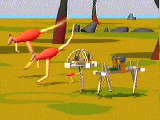 On The
Run, a cartoon animated with automated characters that use
physics-based simulation and task-level control.
On The
Run, a cartoon animated with automated characters that use
physics-based simulation and task-level control. The Leg Lab uses physics-based computer simulation to study robot control systems, animal behavior, and to create automated computer characters.
We have also been investigating the use of robotic simulation and control as a means of generating motion for animated creatures to be used in entertainment and education. Using dynamic simulation and control systems to animate imaginary creatures could free the traditional animator from specifying the details of joint and limb motion while producing both physically realistic and natural-looking results.
 On The
Run, a cartoon animated with automated characters that use
physics-based simulation and task-level control.
On The
Run, a cartoon animated with automated characters that use
physics-based simulation and task-level control.
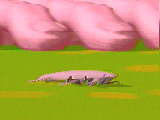 Cockroach Simulation. A simulated cockroach used to examine the
dynamics of locomotion at small scale: do they move dynamically?
Cockroach Simulation. A simulated cockroach used to examine the
dynamics of locomotion at small scale: do they move dynamically?
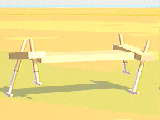 Running Without Control. All of our hopping robots have control systems
which, especially compared to most mobile robots, are fairly simple. These
simulations take it one step further: there is no "control system" in the
sense of something which senses the state and reacts accordingly, yet they
still run.
Running Without Control. All of our hopping robots have control systems
which, especially compared to most mobile robots, are fairly simple. These
simulations take it one step further: there is no "control system" in the
sense of something which senses the state and reacts accordingly, yet they
still run.
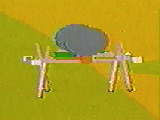 Retuning Control Systems. Elephants, giraffes, horses and dogs have
similar topology but widely differing sizes and proporations. If we had a
control system that worked correctly for one of them, could we easily adapt
it to work on the others. This project explored using a computer program
to automatically tune the control parameters for such variations.
Retuning Control Systems. Elephants, giraffes, horses and dogs have
similar topology but widely differing sizes and proporations. If we had a
control system that worked correctly for one of them, could we easily adapt
it to work on the others. This project explored using a computer program
to automatically tune the control parameters for such variations.
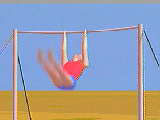 High Bar Simulation. The flip executed while dismounting from a high bar
is physically unstable, yet humans can perform this maneuver consistently. We
have a simulation which can, too.
High Bar Simulation. The flip executed while dismounting from a high bar
is physically unstable, yet humans can perform this maneuver consistently. We
have a simulation which can, too.
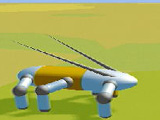 Hexapod Simulation. This is a
simulation of a six-legged walking creature with eighteen actuated
degrees of freedom. Using Virtual Model Control, a simple control
scheme was devised in order to have the hexapod walk in three
dimensions. The hexapod is also able to walk while balancing a two
degree of freedom pendulum on its back.
Hexapod Simulation. This is a
simulation of a six-legged walking creature with eighteen actuated
degrees of freedom. Using Virtual Model Control, a simple control
scheme was devised in order to have the hexapod walk in three
dimensions. The hexapod is also able to walk while balancing a two
degree of freedom pendulum on its back.